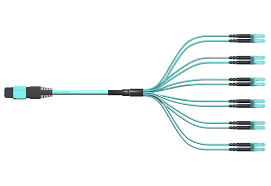Understanding the Importance of MPO to MPO Cables in Modern Networking

In today's fast-paced world of networking, where speed and efficiency reign supreme, MPO to MPO cables emerge as an essential solution. These high-performance cables facilitate rapid data transmission across various platforms, making them indispensable in data centers and enterprise-level networking. In this article, we’ll explore the configurations, specifications, and applications of MPO cables, all while highlighting their crucial role in high-speed data environments.
What Are MPO Cables?
MPO (Multi-fiber Push On) cables allow for high-density fiber connections. By bundling multiple fibers within a single connector, these cables are designed for seamless interconnections, maximizing space while amplifying performance. The most prevalent configurations include MPO to LC breakout cables, which ease connectivity between high-density patch panels and high-performance transceivers.
Key Features of MPO Cables
Fiber Types and Specifications
MPO cables typically use two main fiber types,OM3 and OM4, each catering to various networking needs:
- OM3 Fiber: This fiber features a 50/125µm core, optimized for 10Gb/s transmission rates. It supports distances of up to 300 meters at 850nm and 600 meters at 1310nm, making it a solid choice for moderate bandwidth applications.
- OM4 Fiber: Offering enhanced capabilities, OM4 is designed for 40Gb/s and 100Gb/s transmissions, covering distances of 550 meters at 850nm. This fiber also supports 100Gb Ethernet, making it perfect for environments hungry for bandwidth.
Tip: When choosing MPO cables, keep in mind not only your current handling capacity but also your future expansion needs!
Performance Metrics
When evaluating ***MPO to MPO cables***, performance standards play a critical role. OM3 fibers bring bandwidth levels of up to 1500 MHz-km at 850nm, while OM4 fibers can reach an impressive 3500 MHz-km at the same wavelength. These numbers represent the transmission capabilities that modern networks require for quick data transfer rates.
Connector Types
MPO connectors come in a variety of configurations, including 8-fiber and 12-fiber options. This flexibility makes it easy to integrate them into your existing infrastructure, whether you're linking multiple devices or connecting to patch panels.
Low Loss Parameters
One of the standout features of MPO cables is their low loss characteristics. Typical connector loss sits around **0.3dB**, which is essential for preserving signal integrity over distances. Additionally, the return loss usually hovers around **-25 dB**, which minimizes signal reflection and enhances overall performance.
Length Options
MPO cables are offered in a range of lengths, catering to various installation scenarios. You can find cables as short as 1 meter all the way up to 300 meters, allowing you to select the ideal length for your specific requirements without sacrificing performance.
Applications of MPO Cables
The adaptability of MPO to MPO cables supports high-demand applications across different sectors:
1. Data Centers: In environments where high-speed data exchange is crucial, MPO cables streamline layout design by reducing the space needed for patch panels. This simplification allows data centers to scale operations without extensive rewiring efforts.
2. Video Conferencing and Cloud Computing: As these services require reliable bandwidth and low latency, the high fiber density of MPO cables positions them as the go-to solution for connecting multiple endpoints in real-time applications.
3. Future-Proofing Infrastructure: By adopting MPO technology, businesses can ensure their cabling solutions are equipped for the technological advancements in connectivity, particularly as the demand shifts towards higher data rates like 40G and 100G.
The Integrated Efficiency of MPO Technology
Embracing MPO technology brings significant advantages. The high-capacity, low-loss features not only cater to the current demands of data-heavy applications but also safeguard your network infrastructure for the future. Effective cable management and a streamlined physical layout further boost operational efficiency, ensuring that your networking environment remains agile and responsive.
Conclusion
In summary, MPO to MPO cables are key elements in contemporary networking strategies. Their outstanding performance metrics, versatility, and efficiency make them a must-have for data centers and high-speed applications that necessitate reliable connectivity. By grasping their technical specifications, businesses can make informed decisions when selecting the right cabling solutions tailored to their needs.
As the networking landscape evolves, integrating MPO technology will proactively enhance connectivity and operational performance, empowering businesses to thrive in our increasingly data-driven world.







